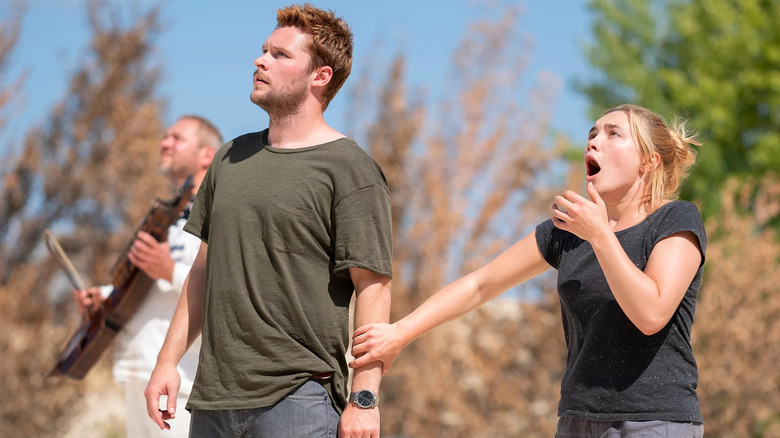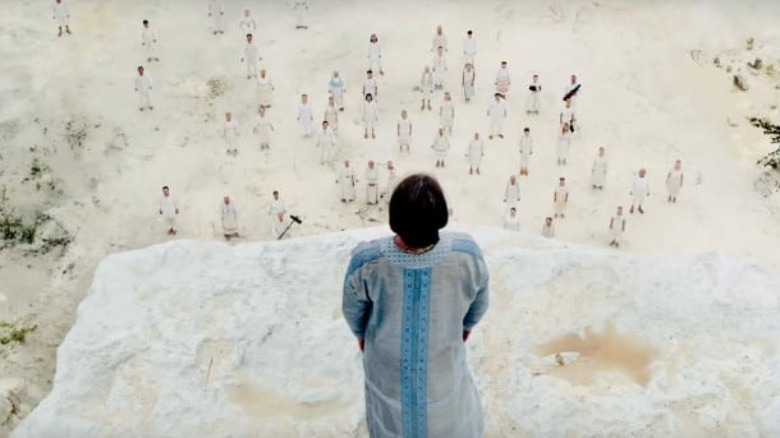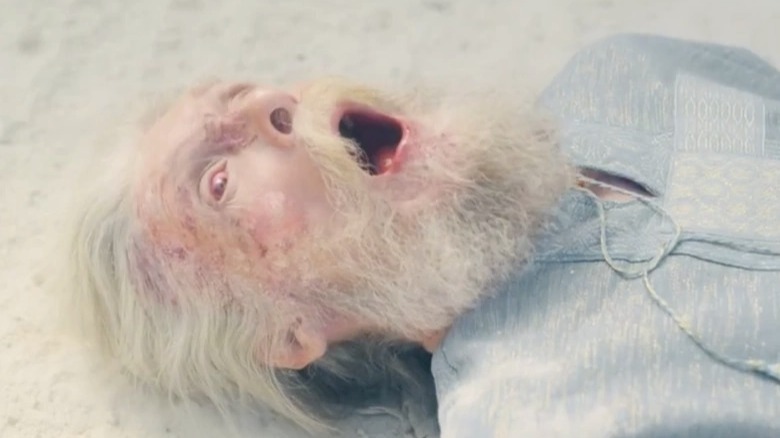The Terrifying Florence Pugh Scene That Still Gives Us Nightmares
In Ari Aster's hypnotic 2019 film "Midsommar," a group of anthropology students visits a remote Swedish commune, where a series of ritualistic horrors unfold in the harsh light of day. The group includes Florence Pugh's Dani, a grief-numbed young woman whose family just died via a gruesome murder-suicide. Strange, dark, and even funny, "Midsommar" follows Dani's surprisingly healing journey into a culture that confronts death head-on.
The movie is filled with unnerving imagery and sequences that purposely disorient, as Aster applies the same freaky horror sensibilities he employed in "Hereditary" a year earlier. Only, while "Hereditary" wove its most disturbing moments into the shadows of night, "Midsommar" ratchets up the tension in the deceptively safe summer sunlight.
One scene, more than any other, propels the group's trip from an uncomfortable vacation to a full-blown nightmare. It also pushes "Midsommar" into straight horror territory. The scene takes place on the group's second day among the Hårga, the cult-like clan of Swedes whom these students are observing for an anthropology project. Dani is recovering from a bad drug trip, and when she joins the group of white-clad locals planted at the bottom of a steep cliff, the camera has a bleary, slightly psychedelic focus.
Dani snaps to attention, though, when she realizes what's about to happen. An old woman (Katarina Weidhagen) stands at the top of the cliff, and as she starts to lurch forwards, Dani grabs her boyfriend's arm with a heaving gasp. Before she can act, the woman steps off the edge, launching herself into a very public and gory death. From that moment on, Aster shoots the sequence from the perspective of Dani's dazed shock. The camera blurs in and out of focus, while the exclamations of her fellow travelers are muffled and contrasted with a droning score.
The ritual of Ättestupa
This scene in "Midsommar" pulls from the folkloric idea of the Ättestupa, a legendary ritual through which Scandinavian elders may or may not have thrown themselves from cliffs in historic times. "This isn't being pulled from historical fact," Aster explained in an interview with GQ, "but it is part of Swedish folklore that people once committed ritual suicide this way, with an audience present."
The scene only gets more nightmarish when a second person jumps. This time, it's an elderly man (Björn Andrésen), and his choking gasps cut through the haze of Dani's shock as he lays with one leg twisted and demolished beneath him. Astonishingly, a group of figures puts the man out of his misery by bludgeoning him with a cudgel in a slow, ceremonial fashion.
Plenty of horror scenes are scary in a way that doesn't linger, but this moment from "Midsommar" has stuck with audiences years later thanks to its perfectly destabilizing design as well as Pugh's shell-shocked performance. On a technical level, the scene pulls off some truly gross imagery, as viewers — like the surrounding crowd — are exposed to the pulpy skulls and torn-up limbs of the elders.
According to Vulture, the sickening shots were created with some impressive practical effects. For shots of Andrésen's mangled body, the crew put the actor in a hole in the ground with only his head sticking out, then connected it to a broken and mangled dummy body. For the bloody head, the team constructed a complex skull featuring pneumatic cylinders that could collapse in on itself and spurt prop blood. Meanwhile, makeup artist Iván Pohárnok and his team painstakingly created realistic human remains by 3D printing digital scans of actors and adding elements like hair by hand.
Aster and Pugh leave audiences shell-shocked
As frightening as the stomach-churning imagery in the Ättestupa scene may be, it works largely because of Pugh's performance as Dani. Even as she reacts to the carnage, Dani seems rooted in place, held there by some power beyond herself. "You're dealing with the logic of why people don't leave when something horrible happens," Aster tells GQ, and Dani has plenty of reasons to stay despite herself. She's an anthropology student, for one thing, and understands that one culture's nightmarish scenario might be another's highest show of respect. She's also stunned by her grief and is still coming down from a hallucinogenic trip, plus she seems drawn into the traditions of the Hårga in an almost predestined way.
We don't see Dani emote much until the film's last moments, when she breaks into a world-flattening scream of catharsis while surrounded by worshipful Hårga. This early in the film, though, Pugh plays her like someone who's too disoriented to control much beyond her own frantic breathing. "It's almost as though after that first impact, she's watching everything from underwater," Aster explained to GQ, adding that Pugh understood the feeling of the scene without much direction. "The moment after the first woman jumps, where it's almost like the dust is knocked off of Dani and she's punched into another reality and just kind of dissociates completely."
By putting audiences through the wringer with this grotesque scene, horror master in-the-making Aster forces "Midsommar" viewers to see the world through Dani's eyes. Only, when the climax comes, the folks watching along can't exactly scream along with her. Instead, they're forced to leave the movie with the feeling of having witnessed a disaster unfolding in slow motion, unable to move or stop it, just like Dani at the bottom of the cliffs.


